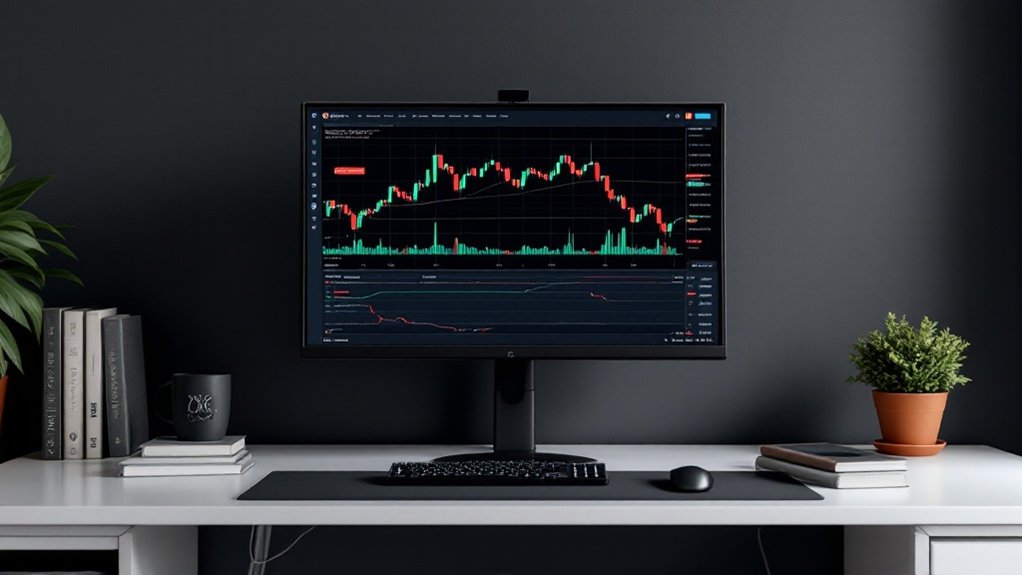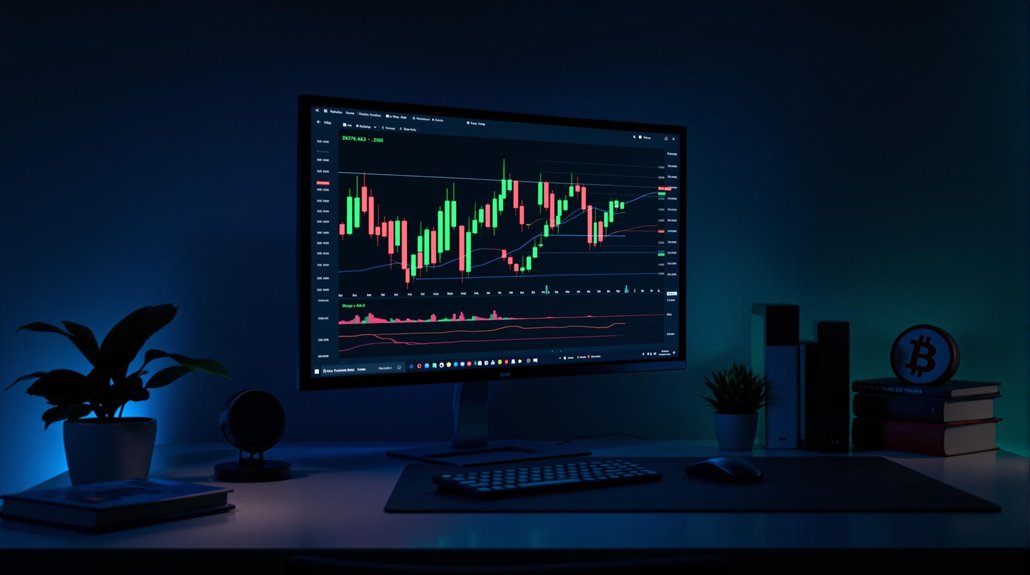Trading cryptocurrency starts with choosing a secure exchange platform and completing identity verification. Traders need to fund their accounts through bank transfers or credit cards, with ACH deposits being a cost-effective option. Two-factor authentication helps protect accounts, while different trading strategies like day trading or long-term investing suit various goals. Moving crypto to secure wallets after purchase adds protection. The world of digital assets offers many layers to explore.
Quick Overview
- Choose a reputable cryptocurrency exchange platform and complete identity verification before funding your trading account.
- Enable two-factor authentication and implement strong security measures to protect your cryptocurrency investments.
- Select a trading strategy that matches your goals, whether day trading, swing trading, or long-term investing.
- Learn to use both market orders for immediate trades and limit orders for specific price targets.
- Transfer purchased cryptocurrencies to secure wallets and maintain backup copies of private keys.

Trading cryptocurrency starts with choosing the right exchange platform. Traders look at different factors when selecting an exchange, including fees, security features, and the types of cryptocurrencies available. Once they’ve picked an exchange, they create an account and complete identity verification. They can then fund their account through various methods like bank transfers or credit cards. ACH deposits are often preferred since they’re more cost-effective than other funding options.
It’s common for traders to spend time learning the exchange’s interface and trading tools before making their first trade. Trading fees can range from 0% to 5% depending on the platform.
Security plays a key role in cryptocurrency trading. Traders typically enable two-factor authentication on their accounts to add an extra layer of protection. This means they’ll need both a password and a second form of verification, like a code sent to their phone, to access their account. The decentralized nature of cryptocurrencies means they operate without central banks controlling their creation or value. Most traders choose custodial exchanges that hold and manage their crypto assets directly on the platform.
Successful traders develop specific strategies before entering the market. Some prefer day trading, where they buy and sell within 24 hours. Others choose swing trading, holding positions for days or weeks. Long-term investors might keep their cryptocurrencies for months or years.
These traders use technical analysis to study price charts and patterns, while also examining fundamental factors like technology developments and market adoption.
When executing trades, traders select specific trading pairs, such as Bitcoin to US Dollar (BTC/USD) or Ethereum to Bitcoin (ETH/BTC). They can place market orders, which execute immediately at current prices, or limit orders, which only execute when the price reaches a specific target.
Before confirming any trade, they review all transaction details carefully.
Cryptocurrency management extends beyond trading. After purchasing crypto, many traders transfer their holdings to secure wallets for safe storage. These wallets can be software-based on computers or phones, or hardware devices that store cryptocurrencies offline.
Traders keep their private keys and recovery phrases in secure locations, as losing these means losing access to their crypto.
The cryptocurrency market operates 24/7, and traders monitor their positions regularly. They often set stop-loss orders to automatically sell if prices drop below certain levels, helping to manage risk.
Successful traders stay informed about market news, security threats, and potential scams. Those with large holdings frequently use hardware wallets, which provide extra security by keeping cryptocurrencies offline.
Regular password updates and security checks have become standard practice in the crypto trading community.
Frequently Asked Questions
What Are the Tax Implications of Trading Cryptocurrency in My Country?
Cryptocurrency trades are taxable events in the U.S. The IRS treats crypto as property, not currency.
When someone sells or exchanges crypto, they’ll owe capital gains tax. Short-term gains (assets held less than a year) are taxed at regular income rates. Long-term gains (held over a year) get lower tax rates.
Mining, staking, or receiving crypto as payment counts as taxable income. All crypto transactions need to be reported on tax returns.
How Do I Protect My Crypto Wallet From Hackers and Scams?
Protecting crypto wallets involves several common security practices.
Two-factor authentication adds an extra layer of security beyond passwords. Hardware wallets, which look like USB drives, keep crypto offline and away from hackers.
Crypto owners often use password managers to create and store complex passwords. They don’t click suspicious links or share private keys.
Regular software updates and avoiding public Wi-Fi networks help prevent unauthorized access to wallets.
Can I Trade Crypto Using My Retirement Account or Pension Funds?
Yes, it’s possible to trade crypto through retirement accounts. Many IRAs and some 401(k) plans now offer cryptocurrency investment options.
Companies like Fidelity let people buy Bitcoin in their retirement accounts. Self-directed IRAs can hold various cryptocurrencies.
Different countries have different rules – Wyoming allows public pension funds to invest in crypto, while Canada’s Ontario Teachers’ Pension Plan has already made crypto investments.
Setup and trading fees may apply.
Which Cryptocurrency Exchanges Are Legally Permitted in My Region?
The legal status of crypto exchanges varies by location. To find permitted exchanges, people can check their country’s financial regulatory website or look up local crypto laws.
In the US, popular regulated exchanges include Coinbase, Gemini, and Kraken. The EU has many licensed platforms like Bitstamp. Japan’s FSA website lists approved exchanges.
Some regions completely ban crypto trading, while others have specific licensing requirements for exchanges to operate legally.
What Happens to My Crypto Assets if the Exchange Platform Fails?
When a crypto exchange fails, user accounts are typically frozen right away. This means people can’t withdraw their money or make any trades.
The exchange usually enters bankruptcy, and customers become creditors who have to file claims to try getting their funds back.
There’s no guarantee they’ll recover everything – it’s common to get back less than what was lost.
The whole process can take months or even years to resolve.





